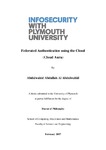Federated Authentication using the Cloud (Cloud Aura)
| dc.contributor.supervisor | Clarke, Nathan | |
| dc.contributor.author | Al Abdulwahid, Abdulwahid Abdullah | |
| dc.contributor.other | School of Engineering, Computing and Mathematics | en_US |
| dc.date.accessioned | 2017-07-06T15:40:40Z | |
| dc.date.issued | 2017 | |
| dc.identifier | 10444635 | en_US |
| dc.identifier.uri | http://hdl.handle.net/10026.1/9596 | |
| dc.description.abstract |
Individuals, businesses and governments undertake an ever-growing range of activities online and via various Internet-enabled digital devices. Unfortunately, these activities, services, information and devices are the targets of cybercrimes. Verifying the user legitimacy to use/access a digital device or service has become of the utmost importance. Authentication is the frontline countermeasure of ensuring only the authorised user is granted access; however, it has historically suffered from a range of issues related to the security and usability of the approaches. Traditionally deployed in a point-of-entry mode (although a number of implementations also provide for re-authentication), the intrusive nature of the control is a significant inhibitor. Thus, it is apparent that a more innovative, convenient and secure user authentication solution is vital. This thesis reviews the authentication methods along with the current use of authentication technologies, aiming at developing a current state-of-the-art and identifying the open problems to be tackled and available solutions to be adopted. It also investigates whether these authentication technologies have the capability to fill the gap between the need for high security whilst maximising user satisfaction. This is followed by a comprehensive literature survey and critical analysis of the existing research domain on continuous and transparent multibiometric authentication. It is evident that most of the undertaken studies and proposed solutions thus far endure one or more shortcomings; for instance, an inability to balance the trade-off between security and usability, confinement to specific devices, lack or negligence of evaluating users’ acceptance and privacy measures, and insufficiency or absence of real tested datasets. It concludes that providing users with adequate protection and convenience requires innovative robust authentication mechanisms to be utilised in a universal manner. Accordingly, it is paramount to have a high level of performance, scalability, and interoperability amongst existing and future systems, services and devices. A survey of 302 digital device users was undertaken and reveals that despite the widespread interest in more security, there is a quite low number of respondents using or maintaining the available security measures. However, it is apparent that users do not avoid applying the concept of authentication security but avoid the inconvenience of its current common techniques (biometrics are having growing practical interest). The respondents’ perceptions towards Trusted Third-Party (TTP) enable utilising biometrics for a novel authentication solution managed by a TTP working on multiple devices to access multiple services. However, it must be developed and implemented considerately. A series of experimental feasibility analysis studies disclose that even though prior Transparent Authentication Systems (TAS) models performed relatively well in practice on real live user data, an enhanced model utilising multibiometric fusion outweighs them in terms of the security and transparency of the system within a device. It is also empirically established that a centralised federated authentication approach using the Cloud would help towards constructing a better user profile encompassing multibiometrics and soft biometric information from their multiple devices and thus improving the security and convenience of the technique beyond those of unimodal, the Non-Intrusive and Continuous Authentication (NICA), and the Weighted Majority Voting Fusion (WMVF) and what a single device can do by itself. Furthermore, it reduces the intrusive authentication requests by 62%-74% (of the total assumed intrusive requests without operating this model) in the worst cases. As such, the thesis proposes a novel authentication architecture, which is capable of operating in a transparent, continuous and convenient manner whilst functioning across a range of digital devices – bearing in mind it is desirable to work on differing hardware configurations, operating systems, processing capabilities and network connectivity but they are yet to be validated. The approach, entitled Cloud Aura, can achieve high levels of transparency thereby being less dependent on secret-knowledge or any other intrusive login and leveraging the available devices capabilities without requiring any external sensors. Cloud Aura incorporates a variety of biometrics from different types, i.e. physiological, behavioural, and soft biometrics and deploys an on-going identity confidence level based upon them, which is subsequently reflected on the user privileges and mapped to the risk level associated to them, resulting in relevant reaction(s). While in use, it functions with minimal processing overhead thereby reducing the time required for the authentication decision. Ultimately, a functional proof of concept prototype is developed showing that Cloud Aura is feasible and would have the provisions of effective security and user convenience. | en_US |
| dc.description.sponsorship | Royal Commission for Jubail and Yanbu, Kingdom of Saudi Arabia | en_US |
| dc.language.iso | en | |
| dc.publisher | University of Plymouth | |
| dc.subject | User Authentication | en_US |
| dc.subject | Biometric Authentication | en_US |
| dc.subject | Cyber Security | en_US |
| dc.subject | Information Security | en_US |
| dc.subject.classification | PhD | en_US |
| dc.title | Federated Authentication using the Cloud (Cloud Aura) | en_US |
| dc.type | Thesis | |
| plymouth.version | publishable | en_US |
| dc.identifier.doi | http://dx.doi.org/10.24382/407 | |
| dc.rights.embargodate | 2018-07-06T15:40:40Z | |
| dc.rights.embargoperiod | 12 months | en_US |
| dc.type.qualification | Doctorate | en_US |
| rioxxterms.version | NA |
Files in this item
This item appears in the following Collection(s)
-
01 Research Theses Main Collection
Research Theses Main


